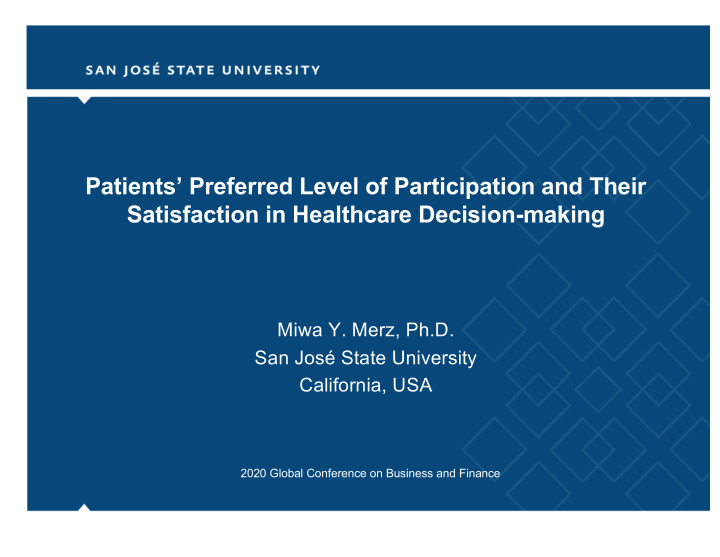



Patients’ Preferred Level of Participation and Their Satisfaction in Healthcare Decision-making Miwa Y. Merz, Ph.D. San José State University California, USA 2020 Global Conference on Business and Finance
What to expect • Insights on patients’ levels of participation in the healthcare decision-making processes and their satisfactions due to the participation • Insights on effective communication strategy between the physician (i.e., provider of healthcare services) and the patient (i.e., recipient or consumer of healthcare services) to encourage patients’ participation and increase their satisfaction in healthcare decision-making processes 2
Content • Introduction – 1.) why study patients’ level of participation and their satisfaction in healthcare decision-making processes; 2.) why investigate a specific Diabetes Mellitus Type 2 (DM2) prevention context. • Research Questions • Literature Reviews • Co-Creation of Value: Service Dominant (S-D) Logic • Three levels of co-creation: physician-dominant, joint, and patient-dominant • Healthcare Literature and Co-Creation • Antecedents of Co-Creation in Healthcare Service Provision • Method • Conclusion 3
Research Questions RQ1: What are patients’ preferred level of decision- making participations across different level of co- creation (physician-dominant, joint, or patient- dominant) in the context of Diabetes Mellitus Type 2 prevention? RQ2: What are patients’ level of satisfaction when engaged in different level of co-creation (physician- dominant, joint, or patient-dominant) in the context of Diabetes Mellitus Type 2 prevention? 4
U.S. Obesity Trends by State: Percent of Obese in U.S. Adults Source: Center for Disease Control and Prevention (2015) http://www.cdc.gov/obesity/data/adult.html 5
Focus on DM2 prevention is important 1.7 million (2008) 1.4 million (2014) 493,000 (1980) Source: CDC (2015). Annual Number (in Thousands) of New Cases of Diagnosed Diabetes Among Adults Aged 18-79 Years, United States, 1980-2014. http://www.cdc.gov/diabetes/statistics/incidence/fig1.htm 6
Literature Review Co-Creation of Value: Service Dominant (S-D) Logic • Customers are always co-creators of value. • Service providers do not provide value to customers, but instead always co-create value together with their customers. • Co-creation process is enhanced through knowledge exchange and active interaction during the service provider-customer encounter. • The concepts of S-D logic and consumer empowerment both highlight the value of co-creation in healthcare context. Anderson (1996); Angelmar & Berman (2007); Grönroos & Ravald (2010); Vargo & Lusch (2004); Vargo, Maglio, & Akaka (2008) 6 7
Three Levels of Co-Creation in Healthcare Physician- Patient- Joint dominant dominant co-creation co-creation co-creation 8
Literature Review Three levels of co-creation in healthcare • Physician-dominant co-creation • Patients cooperate but do not challenge the one-way flow of communication. • Joint co-creation • Two-way flow of communication takes place. • Patients now also share past experiences, symptoms, attitudes toward risk, values, beliefs, preferences etc. • Patient-dominant co-creation • Two-way flow of communication takes place. • Physicians fully explain advantages and disadvantages of all possible treatments. • Information transfer from physician to patient is physician’s key responsibility. • Customer is encouraged to make the treatment decision. 4 9
Healthcare Literature and Co-Creation • Shared decision-making (Alden et al. 2012) • Patient empowerment (Ouschan et al. 2000) • Patient centeredness (Mead et al. 2002) • Patient involvement (Elwyn et al. 2000) • Patient participation (Guadoagnoli et al. 1998) • Patient autonomy (Hayashi et al. 2000) Value is always co-created between patients and physicians during the health service provision process. 10
Healthcare Literature and Co-Creation Prior research has found that co-creation in the healthcare literature has resulted in increased: • patient satisfaction (e.g., Kinnersley et al. 1999) • compliance with treatments (e.g., Ouschan et al. 2000) • health outcomes (Elwyn et al. 2000) • etc. 11
Antecedents of Co-Creation in Healthcare Decision- Makings Various antecedents exist (e.g., disease type and perceived risk) and they influence patients’ abilities and willingness to co-create, hence to participate in decision-making processes Merz, Czerwinski, & Merz (2013) 12
Diabetes Mellitus Type 2 Prevention vs. Treatment • Extensive research on DM2 complication prevention exists, focusing on patients with diabetes (Nothwehr & Stump, 2000; Persell et al., 2004). • However, more research on DM2 prevention is needed that focuses on people who have not yet developed DM2 (i.e., DM2 prevention) vs. who have developed DM2 (i.e., DM2 treatment). 13
Method Experiment 1: I manipulate three levels of co-creation (physician-dominant, joint, and patient-dominant); a simple 3 factorial between-subjects design; 75-100 respondents Experiment 2: I manipulate three levels of co-creation (physician-dominant, joint, and patient-dominant), two disease contexts (DM2 prevention and treatment), and perceived risk (high vs. low); a 3x2x2 factorial between-subjects design; 150-200 respondents 14
Conclusion • Co-creation matters in the healthcare context • Findings will help understand patients’ preferred decision-making styles and their satisfaction based on disease type and perceived risk across three levels of co-creation in Diabetes Mellitus Type 2 prevention and treatment contexts • Findings will help physicians create more effective healthcare services and involve patients in the decision-making processes • Findings help patients obtain better healthcare outcomes and satisfaction 15
Thank you for your attention! Questions or Comments? Contact Information: Miwa.Merz@sjsu.edu 16
Recommend
More recommend